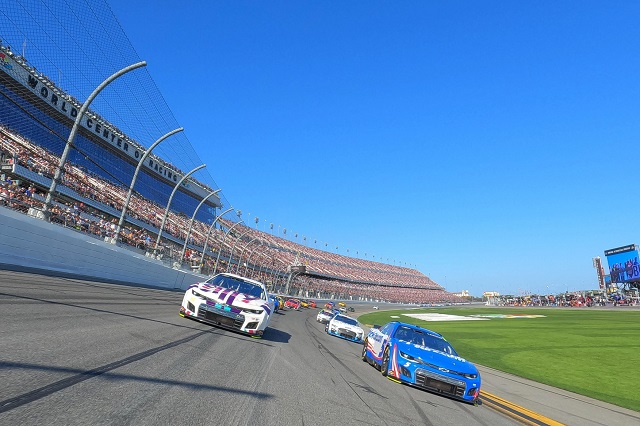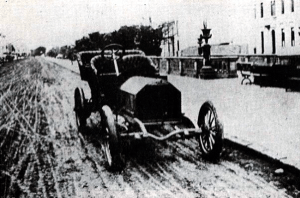Each year, millions of spectators head to speedways across the country to see NASCAR events. Millions more tune in to watch the action on television. It’s a far stretch from when dozens of viewers lined the beaches of Florida to catch a glimpse of early NASCAR races and shows just how far the sport of stock car racing has come.
As the racing circuit celebrates its 75th anniversary in 2023, let’s take a look back at the history of NASCAR.
NASCAR Is Born
The history of NASCAR begins with a man named Bill France, Sr. A mechanic by trade, France owned an auto repair shop in Washington, D.C., until moving to Daytona Beach, Fla. in the 1930s. The area had a well-known racing scene that France joined as both a competitor and promoter. There was just one problem – these early races had no rules or regulations. France believed there needed to be a governing body. He organized a meeting at the Streamline Hotel in December 1947, and this was where the National Association for Stock Car Auto Racing (NASCAR) was born. France would go on to become NASCAR’s first president and was instrumental in the sport’s early growth.
NASCAR was officially incorporated the following year and held its first race on the Daytona Beach Road Course in February 1948. Drivers in these early races used the same cars you’d find on the street. Future Hall-of-Famer Red Byron took the inaugural checkered flag. He also won the first NASCAR season championship the following year.
NASCAR held its first Strictly Stock competition (known today as the NASCAR Cup Series) at the Charlotte Fairgrounds Speedway in June 1949. The most notable entrant was female driver Sara Christian, who became the first woman to race in NASCAR’s premier division.
The Daytona 500
As the sport continued to gain popularity, France quickly came to realize that the sandy beaches of Florida were not suitable venues for racing. They could not handle the growing crowds nor the increasingly powerful cars.
In 1954, France signed a contract with the City of Daytona Beach to build a proper racing track. The Daytona International opened five years later. The 2.5-mile track featured 31-degree highbanks, allowing the cars to reach higher speeds and giving fans a better view of the race. Speaking of fans, 41,000 of them packed themselves into the new venue to watch the inaugural Daytona 500. In a race that featured both hardtops and convertibles, Lee Petty was declared the winner 61 hours later, when officials watched a news clip of him eking out a 2-foot victory over his nearest competition.
NASCAR Goes National
In 1972, France handed over the NASCAR reins to his son, Bill France, Jr., who became the organization’s second president. Over the proceeding years, the younger France oversaw the next chapter in the history of NASCAR, one that saw the racing circuit evolve from a regional attraction in the Southeast to a popular sport across the country.
A major milestone in that process occurred when CBS aired the 1979 Daytona 500. It marked the first live, flag-to-flag broadcast of a 500-mile NASCAR event. Also helping the sport’s popularity was the emergence of star drivers. To this day, few, if any, drivers have come close to matching the greatness of Richard Petty. The son of Lee Petty, Richard first entered a NASCAR race in 1958. Over the next 34 years, he would collect a staggering number of records that still stand today, including most wins (200), most wins in a season (27), most Daytona 500 wins (7) and a tie for most championships (7).
Petty’s last race was the 1992 season finale at Atlanta Motor Speedway, which coincidentally was the first NASCAR race for future Hall-of-Famer Jeff Gordon. Equally talented and charismatic, Gordon took the sport by storm in the 1990s and helped bring NASCAR further into the mainstream in the 2000s. He became the first NASCAR driver to host “Saturday Night Live,” and by the time he retired in 2016, had racked up 93 career wins, which remains the third-most in the history of NASCAR.
Recent Milestones in NASCAR History
- 2010: The inaugural NASCAR Hall of Fame class is inducted. It features Bill France Sr., Bill France Jr., Richard Petty, Dale Earnhardt and Junior Johnson.
- 2013: Danica Patrick becomes the first woman to win the pole in NASCAR premier series, accomplishing the feat at the Daytona 500.
- 2016: Jimmie Johnson captures his seventh NASCAR premier series title, tying him with Richard Petty and Dale Earnhardt for the most championships in the history of NASCAR racing.
- 2021: Bubba Wallace wins his NASCAR Cup Series event at Talladega Superspeedway, becoming the first Black driver to win a race since Wendell Scott in 1963.
For more stories like this, visit our auto history page.
One Thought on “The History of NASCAR”
Leave A Comment
Comments are subject to moderation and may or may not be published at the editor’s discretion. Only comments that are relevant to the article and add value to the Your AAA community will be considered. Comments may be edited for clarity and length.















Automobile racing on Floridas eastern beaches began on Ormond Beach (just north of Daytona) in 1907. It was mostly unregulated and many accidents occurred, some fatal. The first official races on Daytona beach started in 1947. The course was half on the sand and half on a paved road, with most accidents (many roll-overs) on the sand portion. In the beginning Hudson Hornets dominated the field, with #6 driven by Marshall Teague winning Daytona in 1951 and 1952. Hudson cars won 79 races in 5 years! After Hudsons, Oldsmobiles, Chryslers and Fords dominated. In 1953 the “factory sponsored” cars started appearing and the original “stock car” could no longer keep up.